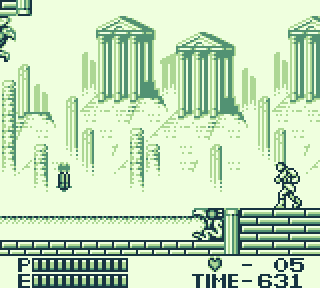Overview

Castlevania II: Belmont's Revenge (not to be confused with Castlevania II: Simon's Quest, and known in Japan as Dracula Densetsu II, which loosely translates to "Dracula Legends II") is a 2D horror-fantasy action platformer developed and published by Konami for the Game Boy in Japan (on July 12, 1991), North America (in August 1991), and Europe (on November 26, 1992).
The sequel to Castlevania: The Adventure, Belmont's Revenge builds on the gameplay by bringing back the series' sub-weapon system and allowing players to play the first four levels in any order (similar to the original games in the Mega Man series).
Set 15 years after vampire hunter Christopher Belmont defeated Count Dracula, the story involves Christopher's son Soleiyu being kidnapped by Dracula's forces and transformed into a demon (aiding the resurrection of Dracula). Players reprise the role of Christopher as he travels through five castles in order to confront Dracula and rescue his son.
The game was later included in the 2019 digital compilation Castlevania Anniversary Collection for the Xbox One, PlayStation 4, Nintendo Switch, and PC.
Gameplay
Refined from its predecessor, Castlevania II: Belmont's Revenge features smoother control and more well thought-out level design.
In this go round, Christopher covers slightly more ground with his jumps, and it seems as if it's easier for the player to land successful jumps. Moreover, the levels seem to have been designed with jumps that are more reasonable for a man of Christopher's athleticism (or lack thereof) to land.
Christopher also walks faster, and while "lumbering" is still an apt adjective for him (or any 8-bit Belmont for that matter), the game feels far more akin to a traditional NES Castlevania title than did its predecessor. Christopher is still slow to climb the ropes used for vertical progress (as did its predecessor, this game lacks stairs), but can now slide quickly down those ropes if the player holds down the "A" button while climbing down. This is not only a convenience but also a necessary mechanic for avoiding moving spike walls while on a rope.
Christopher retains the twice-upgradeable whip (normal to chain to chain-fireball), but no longer loses his upgrade when hit by any enemy (though there are specific enemy attacks may downgrade his whip a level). The chain whip is twice as powerful as the normal whip; each fireball does the same damage as a normal whip strike.
Sub-weapons make an appearance here as well. They are limited to the Axe and Holy Water, but already these are useful additions to Christopher's arsenal and give the player a few more options to tinker with, further separating Belmont's Revenge from the previous game in the series.
Accordingly, hearts do the traditional Castlevania job of serving as ammunition for these sub-weapons. Coins make their return here from the previous game, with the Castlevania staple of pot roast serving as the standard health-replenishment item. 1-ups can also be found on occasion. Hearts, coins, and sub-weapons are found in candles, with pot roast and 1-ups being hidden in destructible walls throughout the game's levels.
Progress
As mentioned above, Christopher can elect the order in which he tackles the first four stages of the game. They are the Crystal Palace; Sky Palace; Plant Palace; and Rock Palace. As their names would imply, each level carries with it its own theme and hazards. Each of these levels is largely linear, though there are limited instances where the player can choose between one of two different paths through a small portion of the level. Capping off each of these levels is a boss enemy
After the initial four bosses have been defeated, Dracula's Castle surfaces in the center of the stage select screen. At this point, Christopher is launched into a completely linear portion of the game that mimics the first Castlevania on NES: Each individual level represents a different area of Dracula's Castle as Christopher battles to the spire.
When Christopher loses all of his lives, he is afforded unlimited continues. Using a continue will drop him at a mid-level checkpoint if he's reached far enough, and the player is also are afforded a password in case they want to pick up Christopher's adventure at a later time. Progression is therefore much more forgiving in this game than its predecessor.
Log in to comment